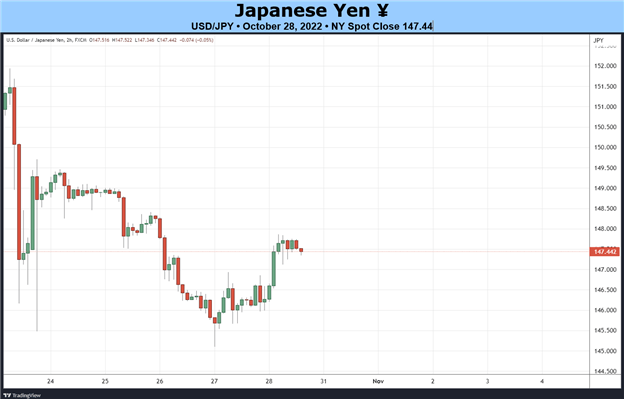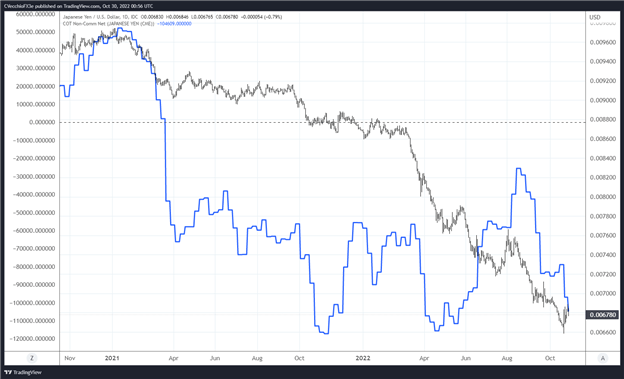
Fundamental Forecast for the Japanese Yen: Neutral
- Intervention efforts may have weighed on USD/JPY rates, but the Japanese Yen was broadly weaker over during the final week of October.
- It remains the case that the Ministry of Finance’s efforts are unlikely to produce a lasting reversal in the Yen, so long as the Bank of Japan’s QQE with yield curve control policy remains in place.
- According to the IG Client Sentiment Index, the Japanese Yen has a mostly bearish bias heading into the first few days of November.
Starts in:
Live now:
Nov 28
( 03:11 GMT )

Join me on Monday, October 31 for the next Markets Week Ahead: Event Risk Trading Strategy session
Weekly Commodities Trading Prep
Register for Webinar
Join Now
Webinar Has Ended
Japanese Yen Week in Review
Buffeted by another intervention at the onset of trading last week, the Japanese Yen was able to secure a positive finish versus the US Dollar, supported by a retracement in US Treasury yields. USD/JPY rates fell back by -0.14%; the pair oscillated between a +1.4% gain and a -1.72% loss.
Yen weakness was flush everywhere else, though. Unlike the September intervention by the Japanese Ministry of Finance, the combined efforts between October 21 and October 24 did little to turn the tide for the Japanese Yen against most of its major peers. GBP/JPY rates surged by +2.72% as new UK Prime Minister Rishi Sunak took power; EUR/JPY rates gained +0.89% as the European Central Bank hiked rates by 75-bps; and CAD/JPY rates still clawed out a +0.19% gain even though the Bank of Canada disappointed market expectations by delivering a 50-bps rate hike.
The Sisyphean Task Continues
The turn lower, if only briefly in USD/JPY rates, highlights the significant obstacles the Japanese Yen still faces. If anything, it remains the case that the Ministry of Finance’s efforts are a clear sign that the Bank of Japan won’t be relenting anytime soon, as discussed in the late-September Japanese Yen weekly fundamental forecast, which the Bank of Japan confirmed this week at its October policy meeting.
The fact remains: with all other major central banks raising rates to combat inflation while the Bank of Japan continues to pursue its QQE with yield curve control policy, the interest rate gap between the Yen and other major currencies will persist. As such, the Ministry of Finance’s intervention efforts will be akin to Sisyphus pushing his boulder uphill.
Recommended by Christopher Vecchio, CFA
Get Your Free JPY Forecast
Quiet Japanese Economic Calendar
In the wake of the October BOJ meeting and the Japanese Ministry of Finance’s latest intervention, it remains the case – just like after the September BOJ meeting and the September 22 MOF intervention – that upcoming Japanese economic data may not carry as much weight. Regardless, it’s a quiet economic calendar, which will keep traders’ focus on the newswire for any fresh intervention news.
- On Monday, October 31, October Japan consumer confidence and September Japan housing starts are due at 5 GMT.
- On Tuesday, November 1, the October BOJ meeting minutes will be published at 23:50 GMT.
- On Thursday, November 3, weekly Japan foreign bond investment figures are due at 23:50 GMT.
Recommended by Christopher Vecchio, CFA
Trading Forex News: The Strategy
JGB Yield Curve (1-year to 30-years) (October 2020 to October 2022) (Chart 1)

The Bank of Japan has made clear that it will continue efforts to keep Japanese government bond yields capped. Accordingly, this remains the prime reason for why it is hard to believe that the Ministry of Finance’s efforts to support the Yen will succeed beyond a short-term timeframe. The singular way to increase the likelihood of a sustained reversal in the Japanese Yen is if the Bank of Japan ends its QQE with yield curve control policy, which does not seem likely any time soon.
CFTC COT Japanese Yen Futures Positioning (October 2020 to October 2022) (Chart 2)

Finally, looking at positioning, according to the CFTC’s COT for the week ended October 25, speculators slightly decreased their net-shortJapanese Yen positions to 104,609 contracts from 96,944 contracts. Japanese Yen positioning is now the most net-short since mid-May 2022, a sign that traders don’t think that recent intervention efforts are likely to be significant enough to alter the longer-term trend of weakness.
Trade Smarter – Sign up for the DailyFX Newsletter
Receive timely and compelling market commentary from the DailyFX team
Subscribe to Newsletter
— Written by Christopher Vecchio, CFA, Senior Strategist

